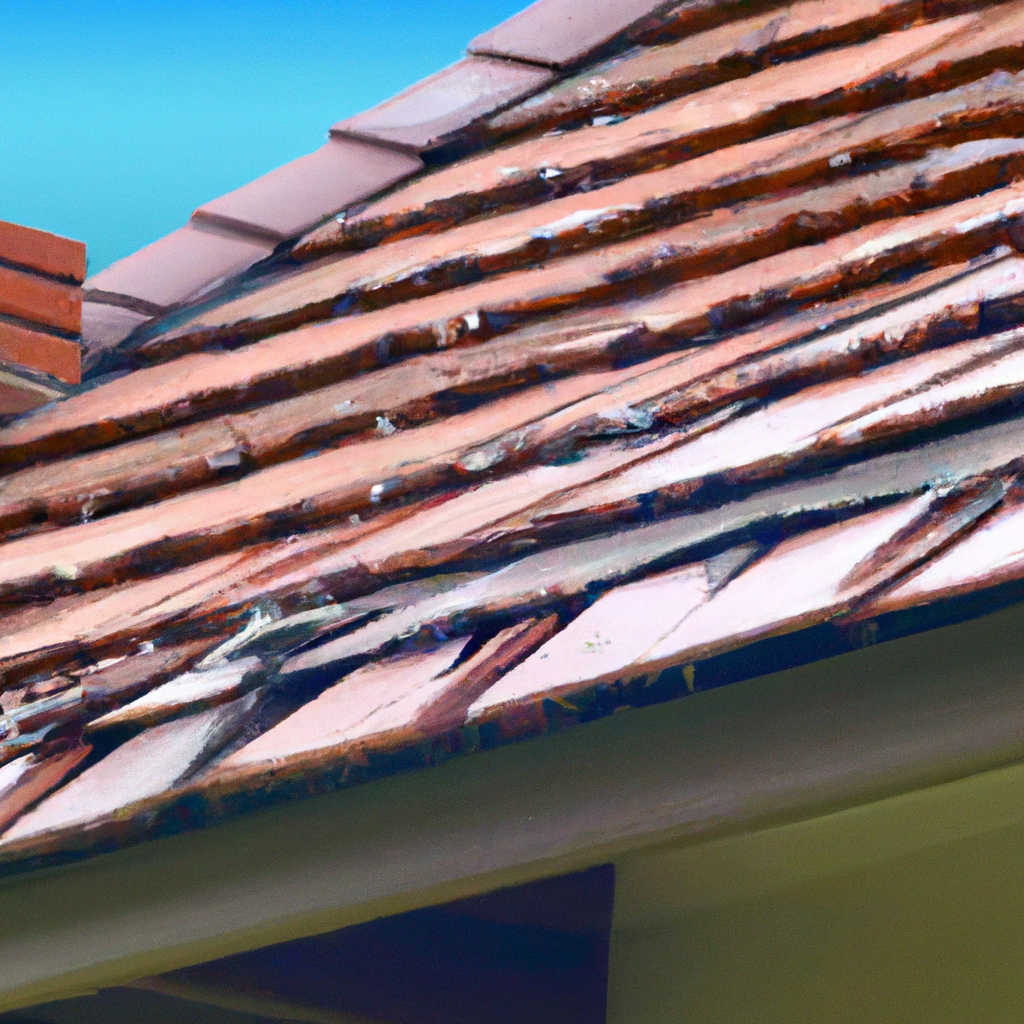Have you ever wondered how long you can leave a roof leak unattended? Picture this: you notice a small drip from your ceiling one rainy afternoon, and you brush it off thinking it’s nothing serious. But have you considered the potential consequences of neglecting the issue? In this article, we will explore the dangers of leaving a roof leak untreated and the potential damages it can cause to your home. So grab a cup of coffee and join us as we uncover the importance of addressing a roof leak in a timely manner.

Potential Damage from Roof Leaks
Structural Damage
When a roof leak occurs and is left unattended, it can lead to severe structural damage. Water seeping through the roof can weaken the support beams and rafters, causing them to rot and deteriorate over time. This can compromise the integrity of the entire roof structure, potentially leading to a collapse or significant damage to the overall building.
Mold and Mildew Growth
Another consequence of ignoring a roof leak is the growth of mold and mildew. Moisture from the leak provides an ideal environment for these fungi to thrive. Mold and mildew not only cause unsightly stains and discoloration on walls and ceilings but can also pose serious health risks. Prolonged exposure to mold spores can trigger respiratory issues, allergies, and other health problems.
Damage to Insulation
Roof leaks can also damage the insulation in your home. When insulation gets wet, it loses its effectiveness in regulating temperature and can even become a breeding ground for mold. This can ultimately lead to increased energy costs as your heating and cooling systems struggle to maintain a comfortable indoor temperature.
Ceiling and Wall Damage
Water seeping through the roof can cause significant damage to your ceilings and walls. The constant exposure to moisture can result in stains, bubbling, peeling paint, and even the formation of cracks. In severe cases, the water may saturate the ceiling or walls to the point of collapse, posing a serious safety hazard to you and your family.
Electrical Issues
One of the most dangerous consequences of a roof leak is the risk of electrical issues. Water that finds its way into your home’s electrical system can cause short circuits, power outages, or even electrical fires. These hazards can lead to significant property damage, injury, or even loss of life. It is crucial to address roof leaks promptly to mitigate the risks associated with electrical issues.
Immediate Actions when Discovering a Roof Leak
Turn off the Electricity
Upon discovering a roof leak, your first immediate action should be to turn off the electricity in the affected area. This will help prevent any electrical hazards that could occur if the water comes into contact with live wires or electrical outlets.
Contain the Water
To prevent further damage, it’s important to contain the water from the roof leak. Place buckets or containers beneath the leak to catch the water and prevent it from spreading throughout the room. You can also use tarps or plastic sheets to cover furniture and other valuables to protect them from water damage.
Move Valuables and Furniture
If possible, move any valuables and furniture away from the affected area to a dry location. By doing so, you can prevent them from getting damaged by the water and mold growth that may occur if the leak is left unattended.
Document the Damage
Take photos or videos of the damage caused by the roof leak. This documentation will be important when filing an insurance claim or seeking professional help. It provides evidence of the extent of the damage and helps ensure proper compensation for repairs and restoration.
Temporary DIY Fixes
While waiting for professional help to arrive, you can attempt temporary DIY fixes to minimize the damage caused by the roof leak. Use roofing cement or a waterproof sealant to cover the area where the leak is occurring. However, it is important to note that these temporary fixes are not a long-term solution and should be followed up with proper repairs by a roofing professional.
Short-term Consequences of Ignoring a Roof Leak
Worsening of Structural Damage
Ignoring a roof leak can lead to the worsening of structural damage over time. As the leak persists, water continues to infiltrate the structural components of your roof, causing further deterioration. The longer the leak persists, the more severe the damage becomes, increasing the risk of partial or complete structural failure.
Increasing Mold and Mildew Growth
When a roof leak is left unaddressed, the moisture creates an ideal breeding ground for mold and mildew. These fungi spread rapidly, affecting not only the immediate area of the leak but also adjacent rooms and surfaces. As the mold and mildew growth continues to expand, it becomes increasingly difficult to eradicate and poses a greater risk to the health of occupants.
Damaged Insulation Becomes Ineffective
A roof leak can saturate and damage the insulation within your home. Wet insulation loses its ability to regulate temperature effectively, compromising the energy efficiency of your home. As a result, your heating and cooling systems will have to work harder, leading to increased energy consumption and higher utility bills.
Continued Ceiling and Wall Damage
When a roof leak is left unattended, the damage to ceilings and walls will continue to worsen. The constant presence of moisture weakens the structural integrity of these surfaces, leading to peeling paint, sagging ceilings, and crumbling drywall. The aesthetic appeal of your home will be significantly diminished, and the costs of repairs and renovations will escalate.
Risks to Electrical System
Ignoring a roof leak also exposes your home’s electrical system to potential risks. When water infiltrates the electrical wiring or outlets, it can cause short circuits, power outages, or even electrical fires. These hazards not only pose a threat to the safety of your home but also endanger the lives of those residing within it.
Long-term Consequences of Ignoring a Roof Leak
Structural Instability
Over time, the constant exposure to water from a roof leak can weaken the structural components of your home. The beams, rafters, and supports may rot or warp, leading to significant structural instability. This can compromise the overall safety and integrity of your home, posing a serious risk to anyone inside.
Extensive Mold Infestation
If a roof leak is ignored for an extended period, it can result in extensive mold infestation. Mold spores thrive in moist environments, and a persistent leak provides the ideal conditions for rapid mold growth. Once mold takes hold, it can quickly spread throughout your home, causing not only cosmetic damage but also severe health issues for occupants.
Compromised Indoor Air Quality
As mold infestation from a roof leak worsens, the indoor air quality of your home will suffer. Mold spores become airborne and can be inhaled by occupants, leading to respiratory issues, allergies, and other health problems. The compromised air quality can be especially harmful to those with pre-existing respiratory conditions or weakened immune systems.
Complete Insulation Failure
Persistent roof leaks can render your insulation completely ineffective. Wet insulation loses its ability to retain heat in the winter and repel heat in the summer, resulting in poor energy efficiency and uncomfortable living conditions. The increased energy consumption required to regulate indoor temperature can significantly impact your utility bills.
Extensive Repairs and Costly Renovations
Ignoring a roof leak ultimately leads to extensive repairs and costly renovations. The longer the leak persists, the more widespread and severe the damage becomes. Repairing and restoring the structural damage, removing mold infestations, replacing damaged ceilings and walls, and installing new insulation can be a lengthy and expensive process.

Health Risks Associated with Ignoring a Roof Leak
Respiratory Issues
The presence of mold and mildew caused by a roof leak can trigger respiratory issues. Mold spores can irritate the respiratory system, leading to coughing, wheezing, and difficulty breathing. Individuals with asthma, allergies, or respiratory conditions may experience exacerbated symptoms when exposed to mold-infested air.
Allergic Reactions
Mold spores are known allergens and can cause allergic reactions in individuals sensitive to them. Symptoms may include sneezing, itching, runny nose, watery eyes, and skin rashes. Prolonged exposure to mold can worsen these allergic reactions and affect the overall quality of life for those affected.
Headaches and Fatigue
Breathing in mold-infested air can also result in headaches and fatigue. The presence of mold spores can disrupt sleep patterns and lead to general feelings of tiredness and lethargy. Continuous exposure to mold without addressing the underlying roof leak can further intensify these symptoms.
Weakened Immune System
Living in a home with a persistent roof leak and mold growth can weaken the immune system. The constant exposure to mold spores can strain the body’s defenses, making individuals more susceptible to illnesses and infections. This compromised immune system can also prolong recovery time from illnesses and impact general well-being.
Exacerbation of Existing Health Conditions
Individuals with existing health conditions, such as respiratory illnesses, allergies, or immune system disorders, may experience a worsening of their symptoms if a roof leak is ignored. The presence of mold and the poor indoor air quality resulting from the leak can exacerbate their conditions and hinder their ability to manage their health effectively.
Factors Affecting the Rate of Damage
Severity of the Leak
The severity of a roof leak plays a significant role in determining the rate of damage. A minor leak may cause minimal damage initially but can escalate if left unattended. On the other hand, a major leak can cause immediate and extensive damage, posing immediate risks to the structure, electrical systems, and occupants of your home.
Roofing Material
The type of roofing material used on your roof can also impact the rate of damage from a leak. Some materials, such as asphalt shingles, may deteriorate more quickly when exposed to water, leading to quicker and more severe damage. Other materials, like metal or clay tiles, may be more resistant to water damage but can still be susceptible if the leak persists.
Climate and Weather
The climate and weather conditions in your area can influence the rate of damage from a roof leak. Regions with heavy rainfall or frequent storms increase the likelihood of water intrusion through the roof. Additionally, extreme temperature fluctuations can cause accelerated deterioration of roofing materials, making them more prone to leaks.
Attic Ventilation
The state of your attic ventilation can impact how quickly a roof leak causes damage. Proper ventilation helps prevent the buildup of moisture, reducing the likelihood of mold growth and rot. If your attic lacks proper ventilation, a roof leak can lead to more rapid and extensive damage due to the trapped moisture.
Quality of Initial Installation
The quality of the initial roof installation can influence the rate of damage from a leak. A well-installed roof with properly sealed joints and flashing is less likely to develop leaks. On the other hand, a poorly installed roof may have weak points that are prone to leaks, leading to quicker and more severe damage if the issue is ignored.

When to Seek Professional Help
Immediate Damage
If a roof leak has caused immediate damage to your home or poses an immediate safety risk, it is crucial to seek professional help immediately. Examples of immediate damage include a collapsed ceiling, significant structural instability, or electrical issues resulting from the leak.
Chronic Roof Leaks
If a roof leak has been persisting for an extended period, it is essential to seek professional help to address the underlying problem. Chronic leaks indicate a more severe issue with your roof and can result in extensive damage if not properly repaired.
Visible Mold Growth
The presence of visible mold growth resulting from a roof leak warrants professional assistance. Mold can be challenging to eradicate entirely, and remediation requires specialized equipment and expertise to ensure thorough removal and minimize health risks.
Sagging or Cracked Ceiling
If you notice your ceiling sagging or cracking due to a roof leak, it is crucial to contact a professional roofer. These signs indicate significant structural damage and pose a serious safety risk. Immediate repairs will be necessary to prevent further deterioration or collapse.
Water Stains or Dampness
Water stains or dampness on your ceilings or walls are indicators of a roof leak. While they may initially seem minor, they should not be ignored. Contacting a professional to assess the extent of the leak and repair the roof is vital to prevent further damage and health risks.
Preventing Roof Leaks
Regular Roof Inspections
To prevent roof leaks, regular roof inspections are crucial. Inspections should be conducted at least twice a year, with additional checks after severe weather events. A professional roofer can identify and address potential issues before they develop into leaks, prolonging the lifespan of your roof.
Prompt Repairs
Addressing any signs of damage or potential issues promptly is essential in preventing roof leaks. Whether it’s loose shingles, damaged flashing, or clogged gutters, prompt repairs can prevent small issues from escalating into significant leaks.
Gutter Maintenance
Proper maintenance of your gutters is essential in preventing roof leaks. Clogged or damaged gutters can cause water to overflow onto the roof, leading to potential leaks. Regularly cleaning and inspecting your gutters will help ensure proper drainage and reduce the risk of roof damage.
Ensuring Proper Attic Ventilation
Proper attic ventilation plays a vital role in preventing roof leaks. A well-ventilated attic helps regulate moisture levels and prevent the buildup of condensation, minimizing the risk of mold growth and damage to the roof’s structure. Ensuring proper airflow and ventilation in your attic can significantly extend the lifespan of your roof.
Quality Installation
Hiring a reputable and experienced roofing contractor for your roof installation is essential in preventing future leaks. A properly installed roof with high-quality materials and attention to detail reduces the risk of leaks from the start. Investing in quality installation can save you from major headaches and expenses down the line.

Insurance Coverage for Roof Leaks
Reviewing Your Policy
When it comes to insurance coverage for roof leaks, it is crucial to review your homeowner’s insurance policy. Familiarize yourself with the coverage limits, deductibles, and exclusions that may affect your ability to file a claim for roof leak damages.
Understanding Exclusions and Limitations
Insurance policies may have exclusions and limitations related to roof leaks. These can include limitations based on the age of your roof, the cause of the leak, or the type of damage covered. Understanding these exclusions and limitations beforehand will help you manage your expectations and plan accordingly.
Filing a Claim
In the event of a roof leak, it is important to promptly file an insurance claim. Contact your insurance company and provide them with all the necessary documentation, including photos or videos of the damage. Be prepared to answer any questions or provide additional information they may require.
Working with Insurance Adjusters
Insurance adjusters play a crucial role in assessing the damage and determining the coverage provided for your roof leak. Cooperate fully with the insurance adjuster, providing them access to the damaged areas and any additional information they may request. Maintaining open communication throughout the process will help ensure a fair and accurate assessment of the damage.
Documenting Damages
Thoroughly document all the damages caused by the roof leak, keeping records of repair estimates, invoices, receipts, and any correspondence with your insurance company. Proper documentation is crucial in supporting your insurance claim and ensuring that you receive appropriate compensation for the repairs and restoration needed.
Conclusion
Addressing roof leaks immediately is of utmost importance to prevent further damage and mitigate potential risks. The potential consequences of ignoring a roof leak range from structural damage and mold growth to compromised indoor air quality and extensive repairs. Prompt action, such as turning off the electricity, containing the water, and documenting the damage, can help minimize initial harm. However, it is essential to seek professional assistance when necessary to ensure proper repairs and prevent long-term consequences. Regular maintenance, inspections, and ensuring appropriate insurance coverage provide a proactive approach towards a leak-free roof and a safe, healthy living environment. By taking responsibility for your roof’s well-being, you can protect your home, your health, and your peace of mind.
